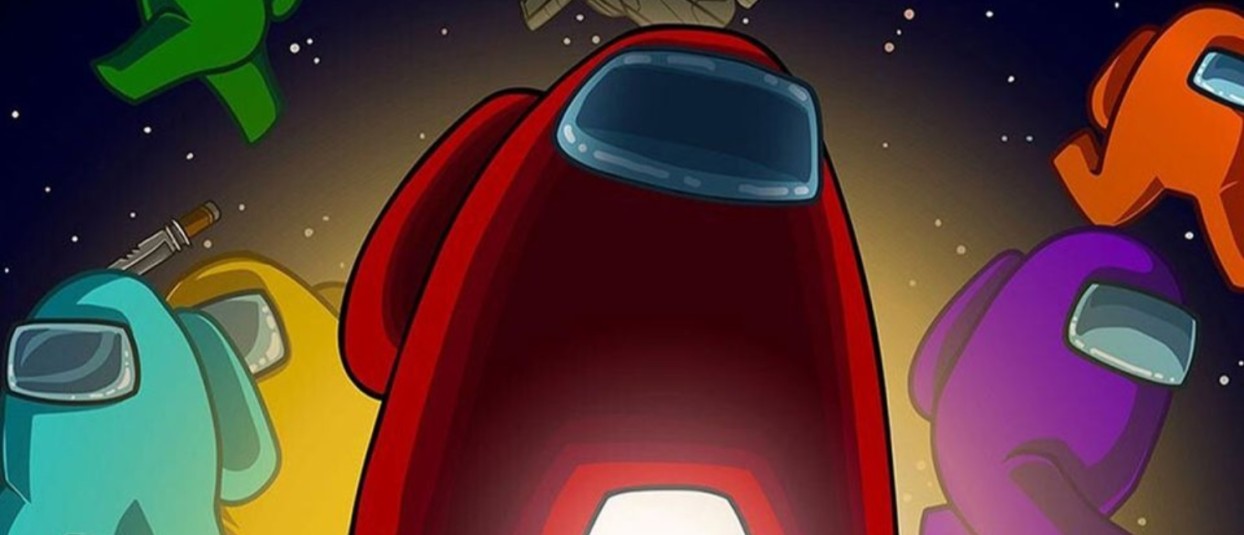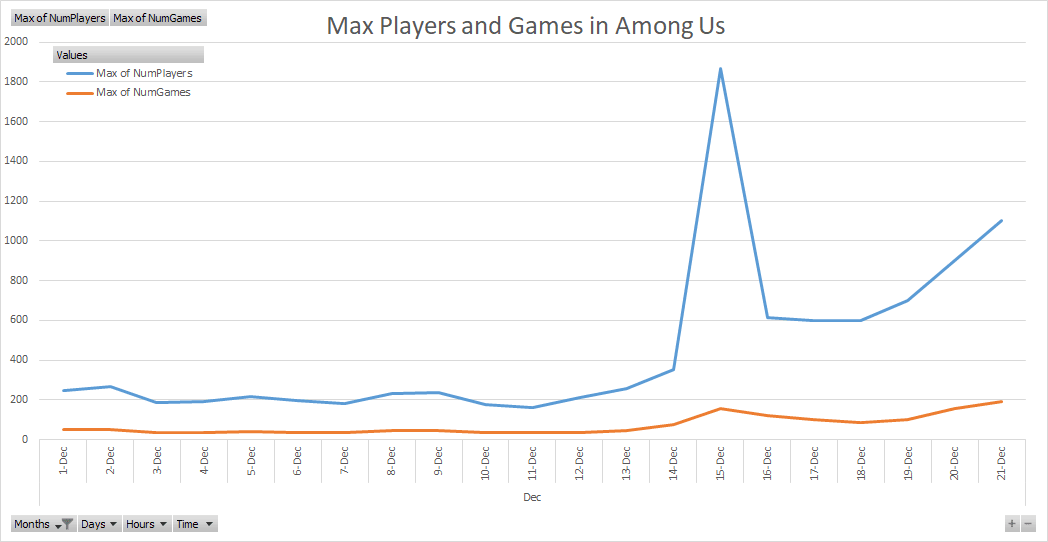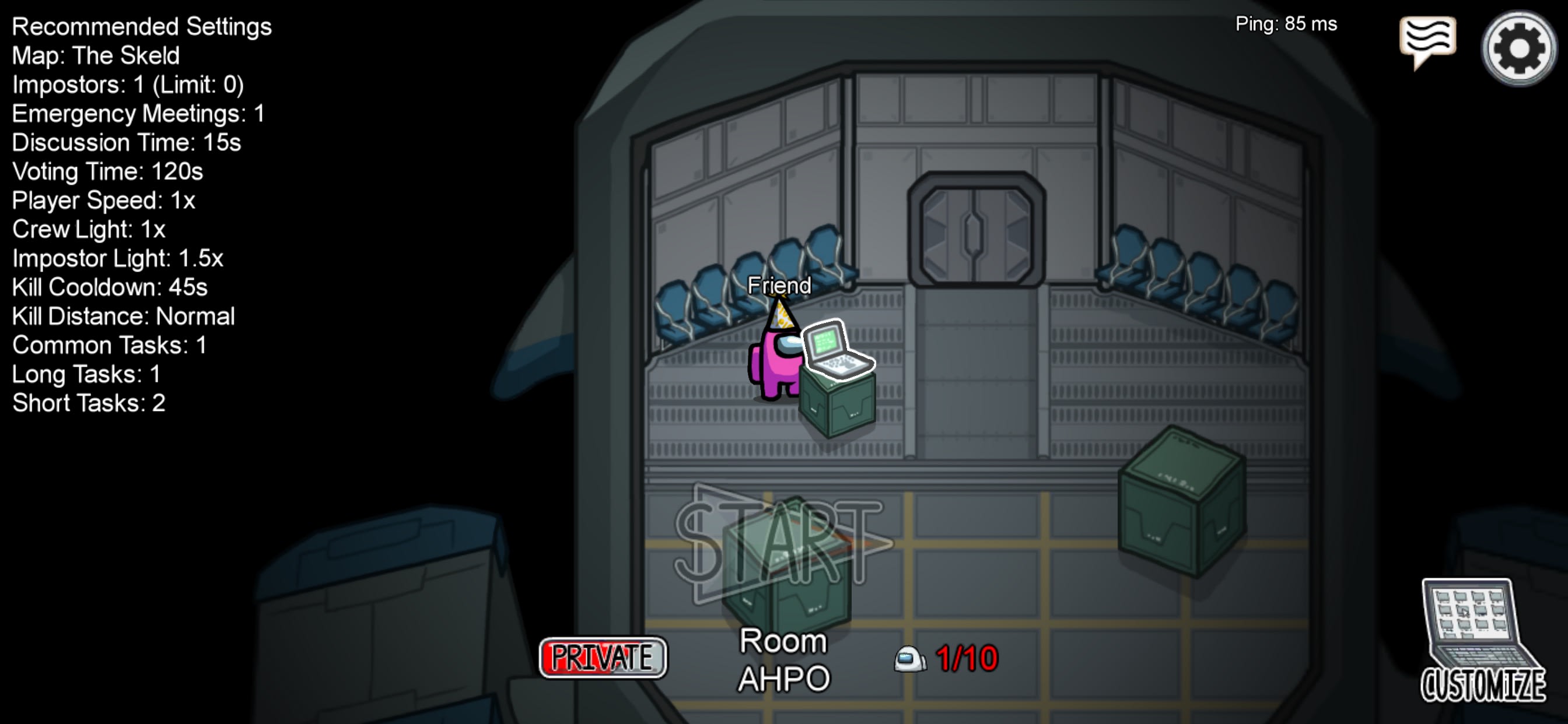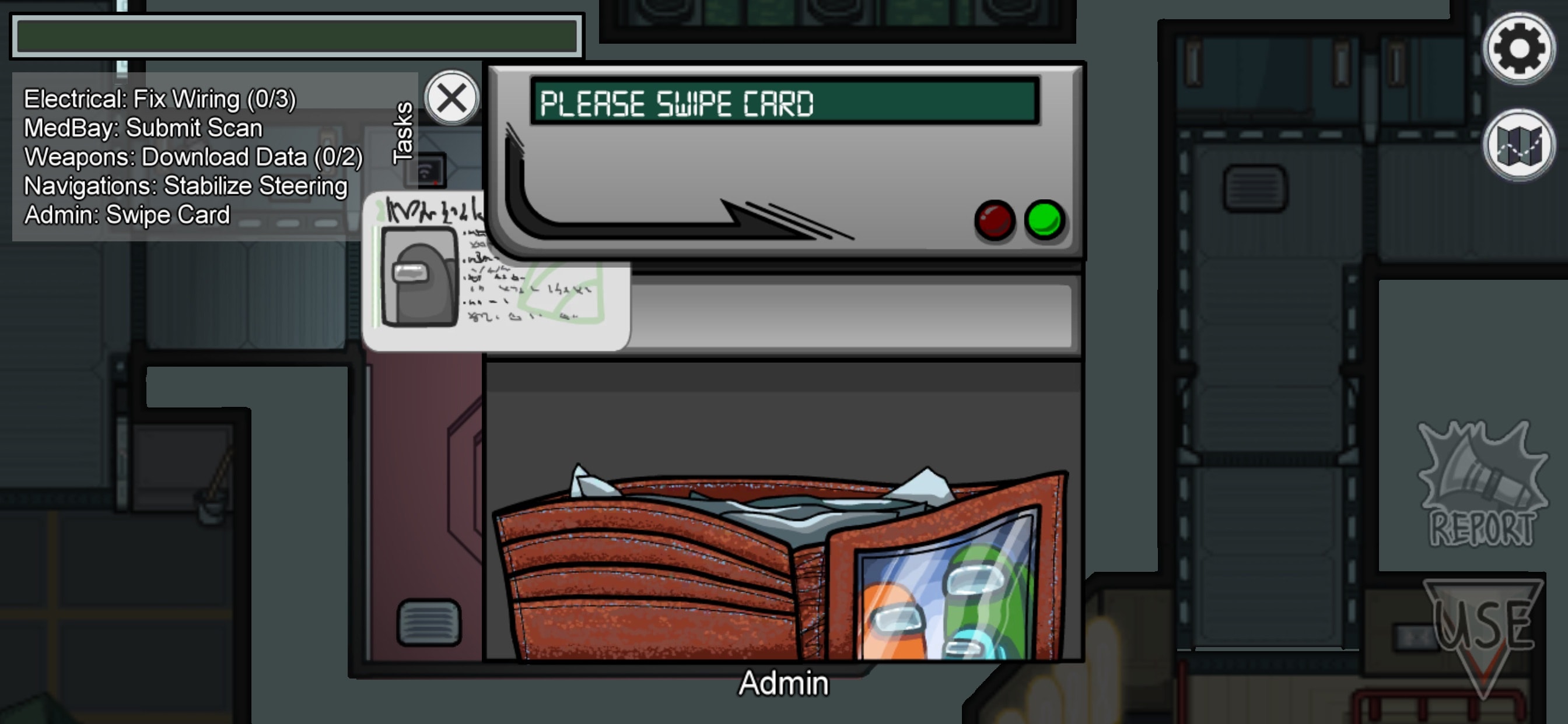It’s not every day that a mobile game, developed by an indie developer with a three or four-person team, becomes the most downloaded game in the app stores.
We’re all happy to assume that in order to grow a successful mobile game (or app) you need:
- A significant investment in paid user acquisition
- A significant investment in generating organic growth
- A great App Store Optimization operation (keywords & creative optimization)
- A world-class product with great game mechanics
- State of the art analytics to guide the development and growth efforts in the right direction
- Superb monetization mechanics
- Potentially leveraging IP and brand marketing
- Investment in retention and re-engagement
- And more…
However, InnerSloth, the team behind Among Us, had almost none of these factors in play when they launched the game. They still don’t have most of it in place, with exactly four people on their team according to their company profile.
So how come an understaffed and under-resourced team managed to manufacture such a success?
Well, given that some of the team members are pretty vocal with their opinions as to why it happened, we can assume it has nothing to do with an elaborate growth strategy planned out in advance.
As Marcus Brommander, the game designer and artist put it:
“… we were really bad at marketing”
I do believe we, the entire mobile marketing and growth industry, have a lot to learn from what Brommander and his team stumbled upon and smartly took advantage of. At the end of the day, we’re in the business of discovering the science of mobile growth, and the science that led to Among Us’ growth can and should be replicated.
So let’s dive in!
What is Among Us?
Among Us is a cross-platform game that allows you to play with friends or strangers online and follows the mechanics of the good old Mafia/Secret Hitler/Werewolf game where you try to work with a group to identify a “traitor”. In short, you play with a group of people in a spaceship (there are two other possible maps) and one or more people are “imposters”. The non-imposters or crewmates try to accomplish various tasks to maintain the ship and the imposters try to sabotage the ship as well as kill crew members.
The crew tries to identify, then discuss, agree, and vote on getting rid of the imposters by throwing them to outer space. The imposters of course will try to confuse the crew as much as possible by derailing their conversation.
Each game has 4-10 people in it, and a game round takes between 2-10 minutes to complete.
So although the game itself didn’t have any significant IP or brand weight, it did build on top of the well-known Mafia game mechanic which is loved around the world.
Click here to see the game in action.
When was Among Us launched?
Among Us was launched on June 15, 2018 on mobile and by November 2018 rolled out for PC as well.
Which platforms were Among Us launched on?
Among Us is available on iOS, Android, and PC (through Steam).
How is Among Us monetizing its users?
Among Us is running ads on the mobile version, selling a no-ad in-app purchase for $1.99, as well as selling skins and character add-ons on Steam. Recently the Among Us team also launched a merchandise store, although this is its most negligible revenue source.
Why Was AMONG US Live For Two Years With No Traction?
That’s actually fascinating. Based on the team, at first they had 5-25 concurrent users playing the game, barely enough to run three different game rounds.

The game started to grow (very slowly) and caught on with Brazilian and Korean Twitch streamers who streamed themselves playing the game. That led to some slight growth throughout late 2018 and 2019, and the first wave happened at the end of 2018:
When the game attracted about 1,800 concurrent players in a single day it was still nothing to write home about.
“It was found by someone in Korea,” said Bromander in an interview. “That helped us get popularity there, and then sometime in the middle of 2019, [a YouTuber] in Brazil played it, and their fanbase picked it up, and it’s just been kind of slowly growing from there.”
There was mostly nothing meaningful happening until the summer of 2020.
In the same piece, one of InnerSloth’s programmers, Forest Willard, said:
“I learned that he [Sodapoppin} was told by Pluto, who works [on the partnerships team] at Twitch,” said Willard. “And I have this, like, genealogy worked out in my mind: I think Pluto learned about it from the Steam sale, and the Steam sale happened because of a daily deal, and there’s this whole chain [of events]. So then Sodapoppin pulled in xQc and Andy Milonakis and a bunch of other guys, and they just played it.”
So according to Willard, after they launched a daily deal on Steam, and got picked up by a Steam Sales event, someone from the partnership team on Twitch told an extremely popular Twitch streamer Chance Morri AKA Sodapopin (with more than 2.7 million followers and over 323 million views) about the game.
What happened next is that Sodapoppin simply gathered a bunch of his fellow streamers each with a large following, and started streaming them playing the game on Twitch. I actually found the moment in which it happened and you can watch it here (min 19:40).
The result of that was massive and the rest, as they say, is history.
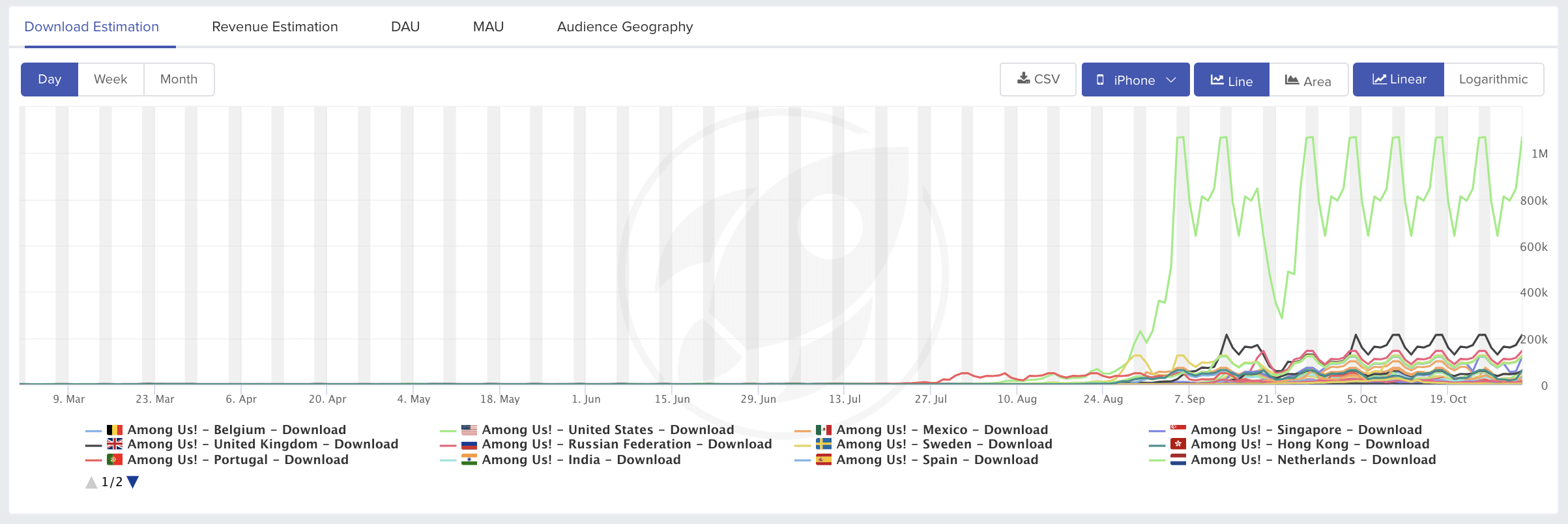
In less than a couple of weeks, Among Us shot up to about 4M-6M weekly installs in the US, and is still within that range as I write these words. As you can see by the red line (South Korea) the game was already somewhat gaining traction in the country, but it was still pale compared to the success in the US.
YouTube themselves released some figures showing that in September, Among Us related video views topped four billion.
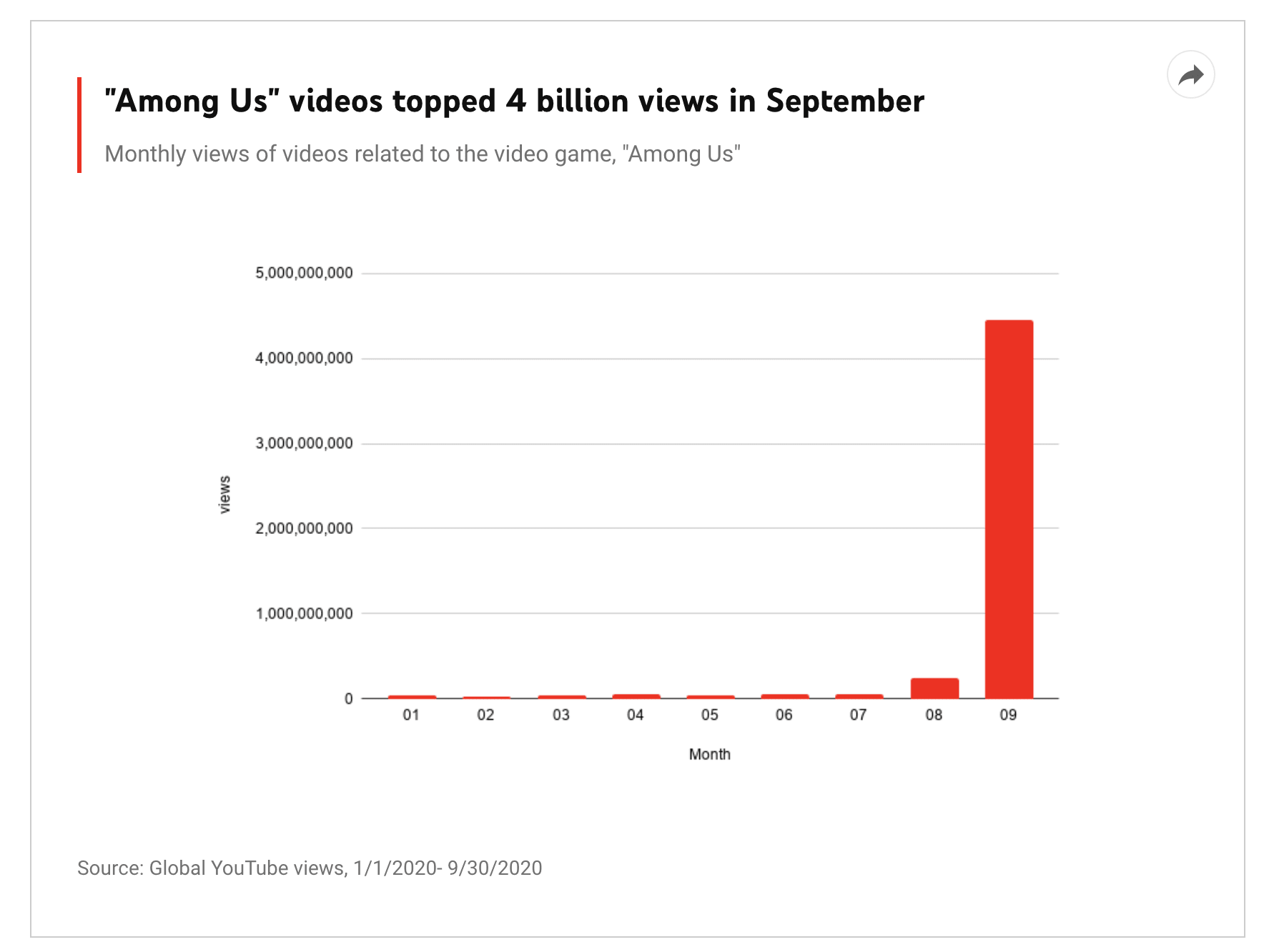
Today the game boasts about 1.5 million concurrent players and is still growing. It’s the most downloaded game and app in the App Store, climbing in the ranks to #1 shortly after it exploded in popularity.

All without spending a single dollar on paid user acquisition on Facebook, Google or any other ad network. Nor were any Apple Search Ads run for Among Us either.
And according to one interesting analysis,the game’s raked in about $150M-$250M in revenues since its rapid growth in September, a sum that easily puts it as one of the most grossing games in the world, comparable to hits by established studios and public game companies.
Watch the revenue analysis of Among Us if you’re interested in the monetization aspect of it.
Identifying Among Us Growth Loops
After understanding its unbelievable growth story, let’s try to distill the growth loops leading to Among Us’s success.
Again, I simply analyzed the way the game grew, and it’s based on various interviews with the Among Us team – this is not a result of a detailed and planned growth strategy. The team simply had all the mechanics in place for phenomenal growth and were extremely lucky to get Sodapoppin stream at the right time (although I believe it was just a matter of time and biz dev to get famous Twitchers to stream the game).
Getting streamed by a famous Twitcher isn’t enough though. If you work for a large game developer you were probably featured by Apple many times. A sharp increase in awareness and visibility does not translate to ongoing and sustainable growth without more moving pieces.
Let’s define a growth loop before we break it down. A real growth loop is a process in which the growth output (a new user usually) creates an additional input to the process (another new user) and creates a self-reinforcing loop that will keep in motion as long as it has enough “fuel” (the activities and motivations that drive the loop).
Let’s explore them.
The Twitch Growth Loop

So the Twitch growth loop works as follows:
- A new player installed the game.
- The game rises in popularity as its userbase grows, making it more appealing to Twitch streamers to adopt as a game they’ll stream.
- The Twitchers stream the game and expose a large audience to the game.
- Some of these viewers search for the game after seeing how fun it is, as they want to play themselves. Some of them will search for it in the App Store, Google Play (usually branded search) or Steam.
- Some of these searchers will install the game, making it even more attractive to Twitchers that’ll continue to stream the game.
This growth loop works because each party in this growth loop has a very strong “why” to perform its action.
Twitchers
- Want to stream games that would attract the most viewership for social capital and financial incentives, so they need games that people are aware of.
- Want to stream unique and new games that allow them to maximize the entertainment value of their streams. Among Us, as a social game that involves speaking and discussing the game with other players provides them with an optimal platform for that.
Users
- Want to consume entertaining Twitch content.
- Want to discover and play entertaining games themselves.
Without the game having very deep and engaging social features (you have to discuss with your team who you think the imposter is/are) it probably wouldn’t appeal as much to Twitchers.
This of coursed worked for Among Us as it is a cross-platform game. Without launching on Steam they wouldn’t been able to capitalize on this growth loop.
The User Invite Growth Loop

The user invites growth loop is pretty familiar and works as follows:
- A new player installs the game.
- The player experiences the online gameplay (most probably with strangers first).
- The player understands it’ll be x10 more fun to play the game with friends as communication is a big aspect of the game.
- The player invites their friends to play (the minimum number of players for a round is four players, so at least three other players are invited).
- The friends get the invite, search for the game, and install it.
- Some of these friends want to play with other friends as well so they again invite more people.
Looking at the incentives and motivations for users to act throughout this loop, shows us that in order for it to work, the gameplay with friends has to be significantly better than playing against strangers for them to have sufficient motivation to get their friends on the game.
For any such loop to work, the game or app has to become drastically better with more friends on it (think WhatsApp).
So it’s not just any social feature that can increase that motivation. For a PvP game that doesn’t have very deep social interactions throughout a match, it might be enjoyable enough to play against strangers. But because Among Us involves actual conversations, knowing the other players is what makes it so much more fun. This is also enhanced by the fact that COVID-19 quarantine increased the perceived value of social play. So that added more to the motivation of playing with friends and family. I don’t think COVID is enough to explain the game’s success (it was live throughout most of the COVID period), but it’s another contributing factor.
Lastly, for this loop to work efficiently the game itself needs to appeal to a mass audience, including people that aren’t everyday gamers. Given the mechanic of the game resembles Mafia, a very well-known game throughout the world, it’s easy for new players to connect to the idea and start playing.
The App Store Growth Loop

The next loop we’ll explore here today is the App Store Discovery growth loop. As more people install the game for the first time (as a result of the other two loops) Apple starts recognizing the app as “trending” and popular. According to our research and many industry thought leaders, the platform’s algorithms are influenced a lot by the velocity of first-time installs. It looks like this:
- A new player installs the game for the first time.
- The platforms recognize the first time installs.
- The first time install velocity metrics increases.
- The platforms rank the game higher on top charts, category charts, and on the search result page for various keywords as they want to surface great games for their audience to provide the best app experience.
- A new audience of “browsers” is exposed to the app (even if they’ve never heard about it before) and a percent of them converts and installs the game.
So the more first time installs that Among Us gets, the higher they climb on the top charts, and even keyword ranking (it’s ranking #1 for ‘games’).
This exposes the game to a new audience, one that browses the app store looking for new games. Ranking high means that a large portion of that audience is exposed to the game and a percent of that audience will install the game, driving that install velocity even higher which keeps the loop in motion.
This loop works because the platforms (the app stores) are looking to surface the best games and apps to their users, and have a very large incentive to improve the discoverability of that app.
Important factors for this loop
- This loop feeds well from new installs coming in from other loops in play.
- That said, the audience that is exposed to the game in the app store might not have a very strong motivation to install the game such as users coming in through the invite loop or the Twitch loop.
- Thus, the messaging and creatives in the app store are still very important in determining the percent of users (CVR) who will actually install the game.
The Role of App Store Creatives in Among Us’ Growth
In this case, I would argue that the role of app store creatives and messaging for the first two audiences is mostly a reassurance they are about to install THE real Among Us game. For the third audience (app store browsers) the role is to actually sell the unique value proposition of the game.
This means that currently, Among Us is missing out on significant growth through the app store discovery loop as it didn’t invest in app store creatives that communicate to new users the game’s value proposition. Some might even view the current creatives as alienating to new users as they don’t convey the easy learning curve to start playing.
Among Us App Store Screenshots:
The Brand Growth Loop

There is one macro growth loop that is in motion as well. This loop is the brand growth loop. In a nutshell, it means that the better a game/app brand capital, the better the conversion metrics will be for the other growth loops.
By conversion metrics, I mean the conversion from one step to another.
The brand capital in itself is created by more press, and word of mouth around the game. A couple of weeks ago Alexandria Ocasio Cortez (AOC) streamed herself on Twitch playing Among Us which became the third most viewed Twitch stream with more than half a million concurrent viewers. The more well-known the game is the more likely people will respond positively to the next action in the growth loop.
For example, a person that heard about the game from friends or online will more likely tune in to Twitch for a stream, will more likely install the game when they stumble upon it in the app store, and will more likely accept an invite from a friend to play the game.
And the brand loop is reinforcing in and on itself, the bigger the user base, the more people are talking about the game, and other people (on social media or media outlets) have more incentive to cover the game.
What can they do next?
The Among Us team has a very strong growth engine to continue to build on. But the massive amount of fuel (via Twitch) that drove growth up until now has to be capitalized to drive success for years to come.
First, I would recommend investing in the App Store Discovery Growth Loop by optimizing the app stores’ creatives and messaging for new and broad audiences. That will likely unlock significant growth from new audiences outside the Twitch community.
Moreover, expanding into non Twitch audiences by building an additional growth loop via paid ads (taking the revenues that are being generated and targeting new audiences through ads, generating even more growth) is also a move that makes sense for the team.
Then investment in new game content, LiveOps, and retention will ensure that the massive growth in user base translates to a high MAU/DAU figure that eventually drives revenue growth as an ad-monetized app.
Overall I’m extremely happy that the Among Us team has experienced the success of such magnitude. After stumbling upon the DNA of hyper-mobile-growth, the industry can learn to engineer success by learning the building blocks of growth.
Takeaways
This isn’t just a fun success story. It shows us how thinking in terms of growth loops and distilling the science behind growth can help us as mobile marketers and growth people, to engineer success for our own products.
Take these three questions with you as you think about your next growth chapter:
- Does my app have a great content distribution growth loop? Do you have enough motivation for users and stakeholders (such as Twitchers) to distribute your app/game content? How can you make that motivation higher?
- Does my app/game take advantage of the app store discovery growth loop? Do you know which type of messaging and creatives convery new and broad audiences on the app store to capitalize on app store discovery growth? Understanding the role of app store creatives in growth is crucial, ask yourself if you know how different audiences respond to your app store messaging. If you want to test that to improve your growth rates, check out Storemaven app store testing platform.
- Does my app/game get much better with users’ friends/family on it? Do you have a product that becomes better and better with users inviting their friends, family or colleagues to it? Simple social features aren’t enough, does the game/app really help people have deep engagement with other users either for entertainment purposes or for functional purposes (collaborate on a work task for example)?
Try to describe your own game/app growth loop and think about how you can supercharge your growth by adding more growth loops.
If you have any questions feel free to reach out to me at [email protected]











